Updated: 25-Nov-2021
In 1926, after the detente through the Treaty-of-Versailles conditions, Benz and Cie. in Manheim founded by Karl Benz and Daimler Motoren Gesellschaft settled in Stuttgart and Berlin by its founder Gottlieb Daimler, joined together to form the new "Daimler-Benz Aktiengesellshaft"
-Daimler brought the Mercedes name, as was said in the Daimler chapter.

"D-B F-7502"
-The first engine that was authorized to be manufactured -to meet Germany's air requirements- was the old 120 CV Mercedes D-IIa and also a new air-cooled, two-cylinder engine for sport aircraft, the F-7502 with a displacement of 880 cc, giving 22 CV at 3,000 rpm.
-Rear view of the F-7502 engine. Two-cylinder engine giving 20/22 CV.
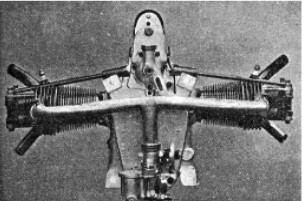
"Two-cylinder engine rear view"
-It had a 0.333 reduction by a planetary gear system. Seen on the Klemm KI-25, among others.
-At the Luftwaffe Museum there is a nice F-7502, as we can see in the photo below.
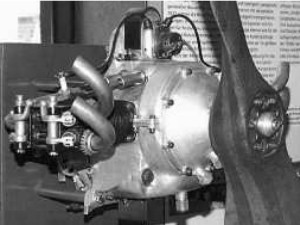
"Daimler-Benz, F-7502"
-In 1928, they already built the 3-cylinder F1 that delivered 34 CV.
-Here's an illustration of it.
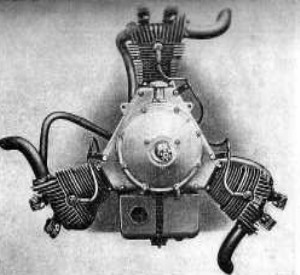
"Daimler F1"
-The path of the cylinder intake duct that we see on the left is disconcerting. It is a long and elbowed course, instead of the more correct ones of the other two cylinders.
-And now a side view.
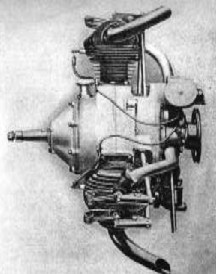
"F1, side view"
-The F2 giving up to 1000 CV with 12 cylinders in V, and liquid cooled was based on the BzVI from WWI.

"F2"
-The F3 was air cooled and was a version of the F2, although both did not came into mass production.
-The F4 had two cylinders in inverted-V, following the requirements of the German Air Ministry.
-Later it would turn out to be the basis for the DB-600 series as F4a.
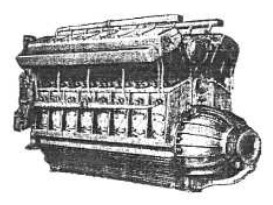
"LoF6"
-In 1932, the "oF2", the F2 diesel variant, appears in V-12. The LoF6 was the Diesel engine on the Hindenburg LZ-129 airship and the Graff Zeppelin II.
-Known as Daimler-Benz and sometimes as Mercedes, the 16-cylinder V-LoF6 engine was intended for use on dirigibles like the famous Hindenburg.
-It delivered 1,200 CV at 1,600 rpm (900 CV continuous power at 1,400 rpm). It was immense, with a total length of 2.69 meters. (8.82 feet).

"Daimler Benz-Mercedes LoF6"
-Now a novelty, a V-12 with diesel type reducer, of the same brand.

"Daimler Benz - Mercedes V-12 Diesel"
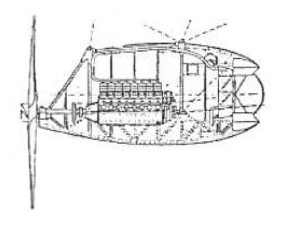
"Gondola with LoF6"
-This engine evolved and was redenominated DB-602. The LoF6 had 16 cylinders in upright-V and it delivered 1050 CV at maximum power and 885 CV continuous.
-Both the LoF6 engine and the oF-2 had a two-stage air compressor for both start and reverse controls.
-They were not supercharged and had reducer of epicycloidal (planetary) gears.
-"The lack of supercharging was justified by the relatively low altitude reached by airships.
-Towards the middle of the decade of the 1930's "Daimler Benz" was assigned number 6 by the Ministry. Thus the engines began to be known by that initial number. The 600 series was to be the best known.
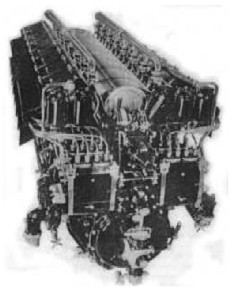
"DB-602"
-Recently we achieved a genuine photograph of a DB-600, as shown below.

"DB-600"
-They were the most built aviation engines by the brand: there were made 19322 DB-601 units, 8758 DB-603 units, and 42405 DB-605 units.
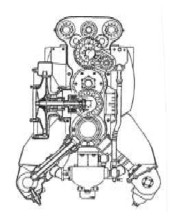
"DB-601A diagram"
-In those days, Daimler-Benz factories were located in various parts of Germany, naturally other subcontractors were involved supplying parts, assemblies and even entire engines.
-The genuine ones were in Stuttgart, Genshagen, Berlin and Manheim by D-B.
-"Henschel" made them in Wiener-Neustadt and Kassel-Altenbauna. In Brunswick they were made by "Niedersachsische Motorenwerke" and in Stetten Arninswalde by "Pommerische Motorenwerke".
-DB-600: In search of greater powers, by 1934 settled the principles of an inverted 12-cylinder V-engine, that was liquid cooled and very compact. The liquid was "Glycol". With almost 34 liters of displacement.
-The supercharged and geared DB-600A already gave more than 900 CV and the DB-600G exceeded 1,000 CV.
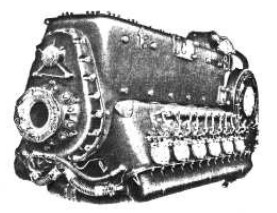
"DB-601Aa"
-The DB-601 was a derivative of the DB-600 with direct gasoline injection and improved supercharger.
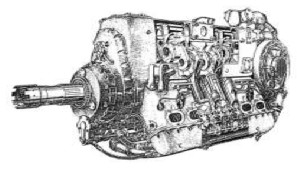
"DB-601 cutaway"
-It is said that because of the poor forward visibility of the pilots that the Germans had during WWI with inline engines that had upright cylinders, influenced the need to make inverted V engines.
-It was not the intention to raise the propeller because with gear, it would descend in the design. But there was the advantage that we can see in the DB-601A scheme shown above and that, like Hispano Suiza "cannon engine", between the cylinder blocks that form the V there could be placed a powerful weapon that fired through the propeller hub, whose shaft was hollow.
-We also observe the arrangement of the 90° supercharger and its coupling in the gearbox.
-We have received photographs made by the factory for the DB-601, prototype 10 that was used to beat the world speed record. It was the DB-601-ARJ. Factory photo (39) 32796.
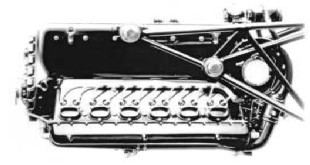
"DB-601"
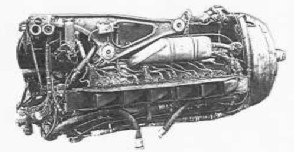
"DB-601E"
-The DB-601, versions A, E, E1, Aa and Ba were installed on the Me-109, although the DB-605 was used on large series of this airplane.
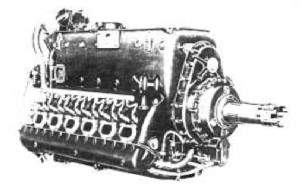
"DB-601 E1"
-The DB-601 ARJ was specially made for the speed record of the Me-109 V1, with 2,300 CV at 3,500 rpm and with water-alcohol injection limited to 1 minute. The E1 engine was the common one for the Me-109 F4, "Fritz".

"DB-602"
-The DB-602, as already mentioned, is the Diesel LoF6. Also with the 16 cylinders in upright V and the planetary gear is maintained.

"DB-603"
-The DB-603 was prolific in versions (A, G, U, E, E, LA, L V, AA, AS K, L M ...) and it gave between 1,500 and 2,000 CV. The A and LA were mounted on the Do-335, one pulling and one pushing (push-pull). And on the FW-Dora, etc. It was larger than the 605.

“DB-603L” (PiP)
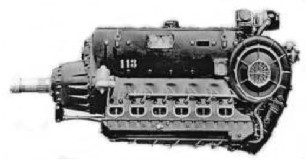
"DB-603, factory photo"
-Photo 37839 for the DB-603 engine with gear and large supercharger.
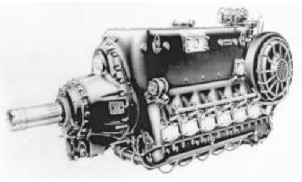
"DB-603 M y L"
-The formidable DB-603 we have in inclined view (Ref. Photo 71143)
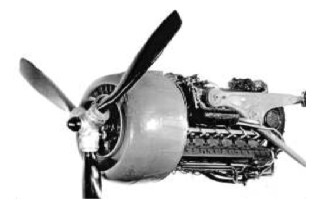
“DB-603, photo 62340”
-As a reversed V-12, the appearance and confusion of considering it to be a radial engine came from the circular shape of the engine fairing. The fact is that it covers a front circular coolant radiator. There are also several DBs, at the engine reserve of the Paris Museum, MAE.
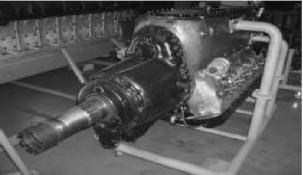
“DB-603 front view at the MAE”
-The DB-603 G and K versions are curious because their main difference from the A was that while the compression ratio of the LH block was 8.3 to 1, that of the RH block was 8.5 to 1, perhaps because of the type of cranks. If it had master and rod or it was a fork, the compression ratio varied.
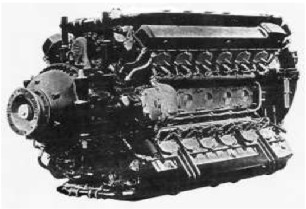
"DB-604"
The DB-604 was an engine that was planned for the Ju-288. It gave 2,000 CV and had 24 cylinders in X. There were two versions, A and B, with a two-speed supercharger. Its development stopped in the year 1942.
-Maybe the DB-604 was Daimler-Benz's biggest engine during the war, without being a coupling of two individual engines, ie new design.
-In the engine stock at the MAE there is one to be restored, a very large one, it looks "massive". It is an engine with 24 cylinders in X, that is to say an upright V together with an inverted V.

"DB-604 at the MAE"

"DB-604, another view of the previous engine"
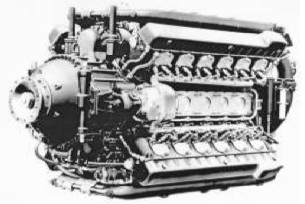
"Factory photo for the DB-604, ref. 43561"
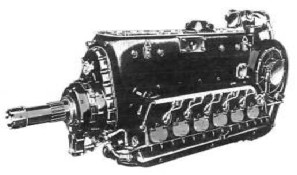
"DB-605A"
-The DB-605 was very similar to the 601, with some improvements, the most visible is the relocation of the spark plugs. In versions A, B, C, D, E, F, DB, AS, ASCM, AM ... and larger.
-The DB-605 was the most built engine by the Daimler Benz during WWII. The DB-606 was a 24-cylinder engine resulting from the coupling of two DB-601, side by side, driving a single propeller through a large gearbox.
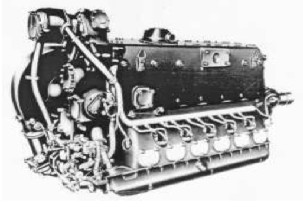
"DB-605A"
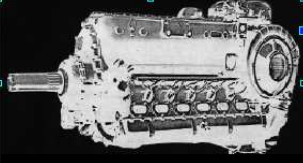
"DB-605D"
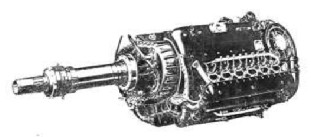
"DB-606"
-The DB-606 was planned for the He-177 and 119 planes. There were two versions, the A and the B but nothing is known about its production. DB-606A, is a double DB-601.
-From the DB-609 we know that there were three versions, A, B and F. It had 16 cylinders in inverted V and its dimensions were similar to the DB-603. The project was abandoned around 1943.
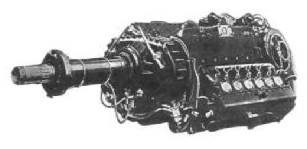

“Two views for the DB-610”
-At the Air and Space Museum in Le Bourget there is a DB-610 with the liquid coolant radiator and mounted on a ground handling stand. The appearance is impressive.

"DB-610 at Le Bourget museum"
-The DB-610 consisted of two DB-605 engines coupled side by side as with the DB-606 (two DB-601) with a large gearbox. It had a total of 24 cylinders. With versions A, B, C, and D reached almost 3,000 CV (2,950 CV in the Dornier Do-317).
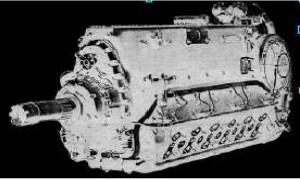
“DB-612” (PiP)
-The DB-612 was a very special engine because it did not use conventional valves but rotating ones, covering and uncovering ports in their synchronized rotations.
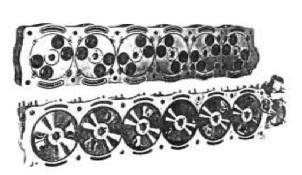
“DB-612 cylinder heads”

“Rotating valve”
-In the figure above we see the rotary valve, serrated at its periphery to make its rotation synchronized. above the rotary valve image there are two cylinder heads one with these valves placed and the other showing the intake and exhaust ports.
-It is the German solution to valveless engines we have already seen from Burt-McCollum and Knight. Although the project was abandoned, an engine of this type is at the MAE in Paris.
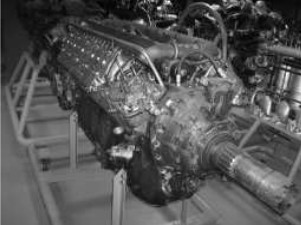
"Daimler Benz DB-612"
-This engine is also turned upside-down with the V of its 12 cylinders up, when the V is normally inverted.
-The cylinder head is cut through the front to be able to see the rotary valve. We this see clearly in the illustration below.
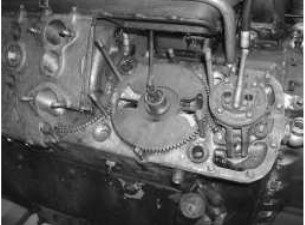
"DB-612 rotary valve"
-This system gave a cylinder-head cleaning and shortened their heights. As we see in the following photograph with a left-side view. Insisting, the engine is placed upside down.
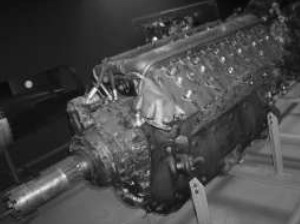
"DB-612"
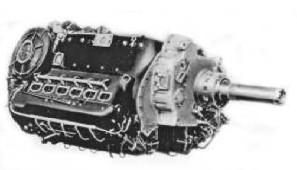
"DB-613, two coupled DB-603 Engines"
-The DB-614 was an advanced development of the 603G reaching 2,000 CV, but the project was abandoned in 1942.
-The DB 615, was a double version of the DB-614 but in tandem and contra-rotating propellers. It gave 4,000 CV. and was also abandoned in 1942.
-The DB-616 was a development from the DB-605 and the project ceased in 1942.
-The DB-617 was an evolution from the DB-603 for long-haul flights. Their development was also stopped.
-The DB-618 was the coupling of two DB-617s and it did not survive either.
-DB-619. Double DB-609 (16 cylinders each) driving a single propeller. In the range of more than 5,000 CV. Its development was abandoned in 1943.
-The DB-620 was the union of two DB-628s (see below). It gave 3,000 CV, and its development was abandoned as well.
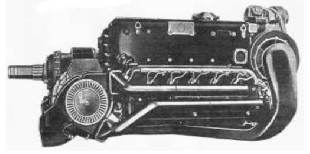
“DB-621”
-DB-621, version with two-stage supercharger, from the DB-605D engine, one compressor at the rear and one at the front. Like many projects it ended in the year 1942.
-The DB-622 had the same development as above but based on the DB-603.

“DB-623, rear view”
-DB-623 rear view that shows the two superchargers. It was based on the DB-603G and was abandoned in 1943.

“DB-624”
-DB-624. This beautiful engine was also abandoned, it was a DB-623 variant based on the same DB-603G.

"Nice photo of the DB-624A"
-The DB-624A seen from this side, shows clearly the exhaust and the intercoolers.
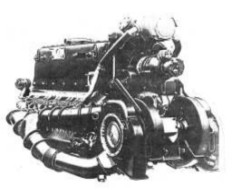
"DB-625"
-The DB-625 was a turbocharged DB-605D.
-The DB-626 was a DB-603G with two turbochargers and cooling the intake by "intercooler" (after cooler). The development ended in 1942.

"DB-627"
-The DB-627 had a two-stage mechanical supercharger and "after cooler" based on the DB-603G. Its development was ended in 1944.

"DB-628"
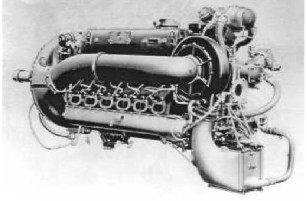
“DB-628, photo ref .71138”
-Better views of the DB-628, the complex engine with a mechanical compressor at the front and a normal supercharger at the rear. Besides an intercooler under the same engine.
-DB-628. The main characteristic of this engine is the mechanical supercharger, around the gearbox for the propeller. Based on the DB-605B.
-There is a second supercharger at the rear accessory part of the engine. It had an intercooler. The project was abandoned in 1944.
-The DB-629 was a mechanical turbocharged DB-609. It did not continue after 1943.
-DB-630. Interesting double W engine, with a total of 36 cylinders. Abandoned in 1943.
-DB-631. is a DB-603G with a 3-stage supercharger, giving 1,900 CV.
-The DB-632 was a DB-603N that was modified to drive counter-rotating propellers with 2,400 CV.

"Airplane with HZ-Anlagen"
-They were installed on Henschel Hs-130E and Do-2127P aircraft. To maintain the power of the engines at altitude, without reducing the engine's superchargers, a third DB-605T engine was installed in the fuselage. This engine "blew" the two DB-603 S or T, which are the main engines on the wings.
-The DB-605T restored the density that the air was losing with altitude and besides it exceeded it far beyond. It reached the altitude of 13.8 Kms. (8.5 miles)
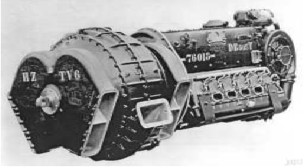
"DB-605T"
-At the front, instead of a propeller we see a big blower with double outlet. The whole line of Daimler Benz 600 series engines have compact, clean, rounded and overall very nice shapes.
-Around 1939 at the same time as Junkers, BMW and Heinkel, Daimler-Benz entered the study of reaction engines, by Professor Karl Leist, an expert on turbochargers until then.

"109-007"
-The first engine was built and ran in 1943, and was called DB-007-ZTL, (from Zweikreis-Turbinen-Luftstrahl) or double-flow.
-The results were not satisfactory because it was a complex engine with little thrust.
-Therefore, the project was stopped by the German Air Ministry in favor of other projects underway. It was March 1944.
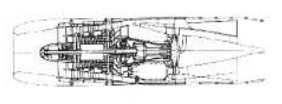
"DB-007-ZTL"
-The unit was officially named 109-007 and had special devices like a compressor and a fan induced in two counter-rotating drums.
-The interior had nine stages of compressor blades while the outside had only three.
-It had four tubular combustion chambers. Many canons of this engine are used in today's turbofans.
-The next engine was a turbojet of normal design but with 13,000 kgf of thrust.
-It is considered the most powerful of the moment, as a reference the diameter of the engine was 2 meters. It was the DB-016 (P-100 Project).

"DB-016"
-Daimler-Benz was also involved in the development of the DB-109-021-PTL turboprop, based on the Heinkel HeS-011 gas generator (see).
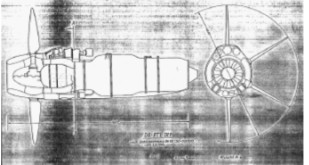
"DB-021-PTL"
-Once WWII ended and with the dispersion of engineers and technicians to other countries - if they did not die in the war -, Germany was depleted in all its motor capacity. The United States, Russia and France were the most benefited.
-In the new Daimler-Benz AG, Stuttgart studies were conducted under the direction of B. Eckert for an engine with 1000 kgf of thrust and shortly before a turboprop of 1000 CV. With these engines they attempted to become a little up to date and beat the delay of the study of aviation engines suffered in the postwar period.
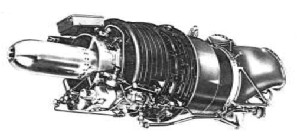
"DB-720"
-The DB-720 was from around 1962 when it only delivered a power equivalent to 1050 CV, increasing immediately up to 1,350 CV, with a consumption of 270 gr / CV / hr.
-This engine had two shafts and a free turbine, weighing 220 kg.
-It had the reference PTL-6 (Propeller-Turbinen-Ausführung).
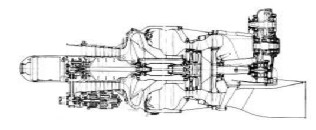
"DB-720"
-The DB-721 had a power equivalent to 2,200 CV with a consumption of 276 gr / hp / hr.
-It had a one-stage working turbine and another one with two stages for the 8-stage axial compressor, one of them was transonic.
-It had the PTL-10 reference.
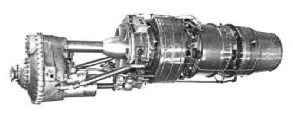
"DB-721"
The DB-730 was a derivative of the DB-720 in which a free turbine drives an axial compressor in the secondary flow duct (dilution index 1.76 to 1). It weighed 220 Kg and gave 610 Kgf of thrust with a consumption of 0'658 Kg/Kgf/Hr. Known as ZTL-6.
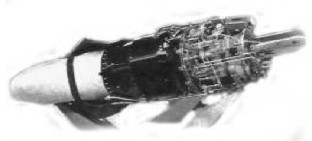
"DB-730"
-The DB-731 was a derivative of the one mentioned above, the same as the 721 was a 720 derivative.
From Appendix 6: We located a project design owing to Leist himself, referring to a turboprop.
-This is a rather original design although taking advantage of the general idea of using an exhaust heat recuperator to heat the air to the combustion chamber intake (Theseus, Chrysler, etc.).s
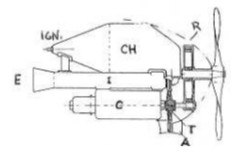
"Leist project outline"
-Legend: C, is the compressor.
CH, is the combustion chamber with its IGN spark plug. Part I is the heat exchanger of the exhaust gases that have their way out through E. T is the turbine with a great device: through A it takes dynamic air to cool their blades. R is the reducer for the propeller.

"Photo of a DB IV-A, Museum in Brussels"
-We see a DB IV-A possibly of the "Pusher" type because of the shape of the profile of the wing section on which its bench is installed, for the inclination and for having the water radiator at the front. And the propeller.
-Now a perfectly restored DB-602 where you can see the double injection pumps on each side (four outlets), each pair feeding an eight-cylinder row.

"DB-602 restored"
-For a better understanding of the superb DB-610, they are two coupled DB-605s through a gearbox and power output by a single shaft. It was predicted for the heavy Heinkel He 177, long distance bomber.

"DB-610, at the NASM"

"Another view of the same DB-610"
-At the rear they have the same mechanical supercharger as the DB-605. It seems that the suspension system is the original as we also see it on the DB-610 engine exposed this time at the Paris Air Museum.
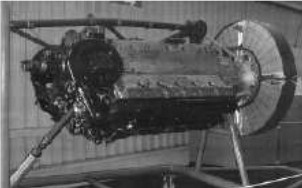
“DB-610 in París”
-Here it has still incorporated the coolant radiator, giving a circular shape to the cowling which lends itself wrongly by indicating a possible radial engine inside.

“OF-2 engine for the Zeppelin LZ.129”
-Now a mini-report on the DB-601 engine, beginning with factory photograph number 32796. First a side view where we can clearly see the double-ignition spark plugs.
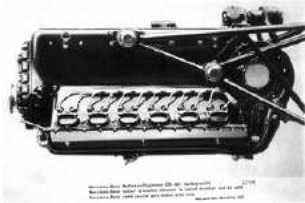
“DB-601”
-Below the assembly line. We are surprised by the youth of the personnel that intervenes.

"Assembly line and test stand"
-It is interesting the test bench with a DB-601 engine, where you can check the performance in various positions.
Engines of DAIMLER-BENZ (Part 1)
Model: 1st aero engine
Arquitecture:
Cooling:
Total Displacement:
Bore / Stroke:
Power: @ rpm
Weight:
Model: 4 cyl. inline 55 CV
Arquitecture:
Cooling:
Total Displacement:
Bore / Stroke:
Power: @ rpm
Weight:
Model: 4xDB-603
Arquitecture:
Cooling:
Total Displacement:
Bore / Stroke:
Power: @ rpm
Weight:
Model: CGT-1
Arquitecture:
Chambers:
Fuels:
Feed System:
Ignition:
Thrust:
Weight:
Model: CHT-0.5
Arquitecture:
Chambers:
Fuels:
Feed System:
Ignition:
Thrust:
Weight:
Model: CHT-1
Arquitecture:
Chambers:
Fuels:
Feed System:
Ignition:
Thrust:
Weight:
Model: CHT-10
Arquitecture:
Chambers:
Fuels:
Feed System:
Ignition:
Thrust:
Weight:
Model: CHT-20
Arquitecture:
Compressor/s:
Combustion chambers:
Turbines:
Power / Thrust:
Weight:
Model: CHT-400
Arquitecture:
Chambers:
Fuels:
Feed System:
Ignition:
Thrust:
Weight:
Model: CHT-5
Arquitecture:
Chambers:
Fuels:
Feed System:
Ignition:
Thrust:
Weight:
Model: DB-109-007
Arquitecture:
Compressor/s:
Combustion chambers:
Turbines:
Power / Thrust:
Weight:
Model: DB-109-016
Arquitecture:
Compressor/s:
Combustion chambers:
Turbines:
Power / Thrust:
Weight:
Model: DB-109-021
Arquitecture:
Compressor/s:
Combustion chambers:
Turbines:
Power / Thrust:
Weight:
Model: DB-600
Arquitecture: 12-cylinder Inverted V-engine
Cooling: Liquid
Total Displacement: 34 Ltr.
Bore / Stroke:
Power: 900 /1000 CV @ rpm
Weight:
The supercharged and geared DB-600A gave more than 900 CV and the DB-600G exceeded 1000 CV.
Model: DB-601
Arquitecture: 12-cylinder Inverted V-engine
Cooling:
Total Displacement:
Bore / Stroke:
Power: 2300 CV @ 3500 rpm
Weight:
The DB-601 was a derivative of the DB-600 with direct gasoline injection and improved supercharger.
The DB-601 ARJ was specially made for the speed record of the Me-109 V1, with 2,300 CV at 3,500 rpm and with water-alcohol injection limited to 1 minute.
Model: DB-602 (LoF6)
Arquitecture: 16-cylinder V-Engine
Cooling:
Total Displacement:
Bore / Stroke:
Power: @ rpm
Weight:
Model: DB-603
Arquitecture: 12-cylinder Inverted V-engine
Cooling:
Total Displacement:
Bore / Stroke:
Power: 1500 / 2000 CV @ rpm
Weight:
Model: DB-604 (X-24)
Arquitecture: 24-cylinder X-engine
Cooling:
Total Displacement:
Bore / Stroke:
Power: @ rpm
Weight:
Model: DB-605 (-T)
Arquitecture: 12-cylinder Inverted V-engine
Cooling:
Total Displacement:
Bore / Stroke:
Power: @ rpm
Weight:
The DB-605 was very similar to the 601, with some improvements. In versions A, B, C, D, E, F, DB, AS, ASCM, AM ... and larger.
Model: DB-606 (2x DB-601)
Arquitecture:
Cooling:
Total Displacement:
Bore / Stroke:
Power: @ rpm
Weight:
The DB-606 was a coupling of two DB-601 side by side, driving a single propeller through a large gearbox.
Model: DB-607
Arquitecture:
Cooling:
Total Displacement:
Bore / Stroke:
Power: @ rpm
Weight:
Model: DB-608
Arquitecture:
Cooling:
Total Displacement:
Bore / Stroke:
Power: @ rpm
Weight:
Model: DB-609
Arquitecture:
Cooling:
Total Displacement:
Bore / Stroke:
Power: @ rpm
Weight:
Model: DB-610 (2x DB-605)
Arquitecture:
Cooling:
Total Displacement:
Bore / Stroke:
Power: @ rpm
Weight:
Model: DB-612
Arquitecture:
Cooling:
Total Displacement:
Bore / Stroke:
Power: @ rpm
Weight:
Model: DB-613 (2x DB-603)
Arquitecture:
Cooling:
Total Displacement:
Bore / Stroke:
Power: @ rpm
Weight:
Model: DB-614
Arquitecture:
Cooling:
Total Displacement:
Bore / Stroke:
Power: @ rpm
Weight:
Model: DB-615 (2x DB-614)
Arquitecture:
Cooling:
Total Displacement:
Bore / Stroke:
Power: @ rpm
Weight:
Model: DB-616
Arquitecture:
Cooling:
Total Displacement:
Bore / Stroke:
Power: @ rpm
Weight:
Model: DB-617
Arquitecture:
Cooling:
Total Displacement:
Bore / Stroke:
Power: @ rpm
Weight:
Model: DB-618 (2x DB-617)
Arquitecture:
Cooling:
Total Displacement:
Bore / Stroke:
Power: @ rpm
Weight:
Model: DB-619 (2x DB-609)
Arquitecture:
Cooling:
Total Displacement:
Bore / Stroke:
Power: @ rpm
Weight:
Model: DB-620 (2x DB-628)
Arquitecture:
Cooling:
Total Displacement:
Bore / Stroke:
Power: @ rpm
Weight:
Model: DB-621
Arquitecture:
Cooling:
Total Displacement:
Bore / Stroke:
Power: @ rpm
Weight:
Model: DB-622
Arquitecture:
Cooling:
Total Displacement:
Bore / Stroke:
Power: @ rpm
Weight:
Model: DB-623
Arquitecture:
Cooling:
Total Displacement:
Bore / Stroke:
Power: @ rpm
Weight:
Model: DB-624
Arquitecture:
Cooling:
Total Displacement:
Bore / Stroke:
Power: @ rpm
Weight:
Model: DB-625
Arquitecture:
Cooling:
Total Displacement:
Bore / Stroke:
Power: @ rpm
Weight:
Model: DB-626
Arquitecture:
Cooling:
Total Displacement:
Bore / Stroke:
Power: @ rpm
Weight:
Model: DB-627
Arquitecture:
Cooling:
Total Displacement:
Bore / Stroke:
Power: @ rpm
Weight:
Model: DB-628
Arquitecture:
Cooling:
Total Displacement:
Bore / Stroke:
Power: @ rpm
Weight:
Model: DB-629
Arquitecture:
Cooling:
Total Displacement:
Bore / Stroke:
Power: @ rpm
Weight:
Model: DB-630 (2x W18 = W36)
Arquitecture:
Cooling:
Total Displacement:
Bore / Stroke:
Power: @ rpm
Weight:
Model: DB-631
Arquitecture:
Cooling:
Total Displacement:
Bore / Stroke:
Power: @ rpm
Weight:
Model: DB-632
Arquitecture:
Cooling:
Total Displacement:
Bore / Stroke:
Power: @ rpm
Weight:
Model: DB-720 (PTL-6)
Arquitecture:
Compressor/s:
Combustion chambers:
Turbines:
Power / Thrust:
Weight:
Model: DB-721 (PTL-10)
Arquitecture:
Compressor/s:
Combustion chambers:
Turbines:
Power / Thrust:
Weight:
Model: DB-730 (ZTL-6)
Arquitecture:
Compressor/s:
Combustion chambers:
Turbines:
Power / Thrust:
Weight:
Model: F-7502, twin-flat
Arquitecture: 2-cylinder Horizontally opposed
Cooling: Air
Total Displacement: 880 cc
Bore / Stroke:
Power: 20 /22 CV @ 3000 rpm
Weight:
For sports aircraft. It had a 0.333 reduction by a planetary gear system.

"Daimler-Benz F-7502"
Model: F1, 3 cyl. radial
Arquitecture: 3-cylinder Radial
Cooling:
Total Displacement:
Bore / Stroke:
Power: 34 CV @ rpm
Weight:

"Daimler F1"
Model: F2, 12V
Arquitecture: 12-cylinder V-Engine
Cooling: Liquid
Total Displacement:
Bore / Stroke:
Power: 1000 CV @ rpm
Weight:

"Daimler-Benz F-2"
Model: F3
Arquitecture: 12-cylinder V-Engine
Cooling: Air
Total Displacement:
Bore / Stroke:
Power: @ rpm
Weight:
The F3 was air cooled and was a version of the F2. It did not came into mass production.
Model: F4
Arquitecture: 2-cylinder Inverted V-engine
Cooling:
Total Displacement:
Bore / Stroke:
Power: @ rpm
Weight:
Model: H-24
Arquitecture:
Cooling:
Total Displacement:
Bore / Stroke:
Power: @ rpm
Weight:
Model: HZ Anlagen
Arquitecture:
Cooling:
Total Displacement:
Bore / Stroke:
Power: @ rpm
Weight:
Model: LoF6, V-16, Diesel
Arquitecture: 16-cylinder V-Engine
Cooling:
Total Displacement:
Bore / Stroke:
Power: 1200 @ 1600 rpm
Weight:
Model: oF2, Diesel V-12
Arquitecture: 12-cylinder V-Engine
Cooling:
Total Displacement:
Bore / Stroke:
Power: @ rpm
Weight:
Diesel variant of the F2.


